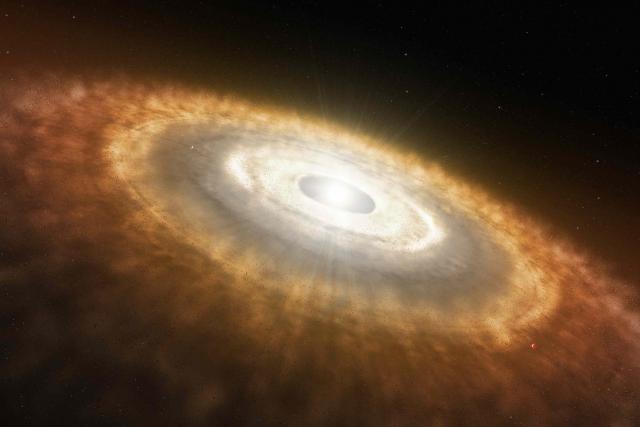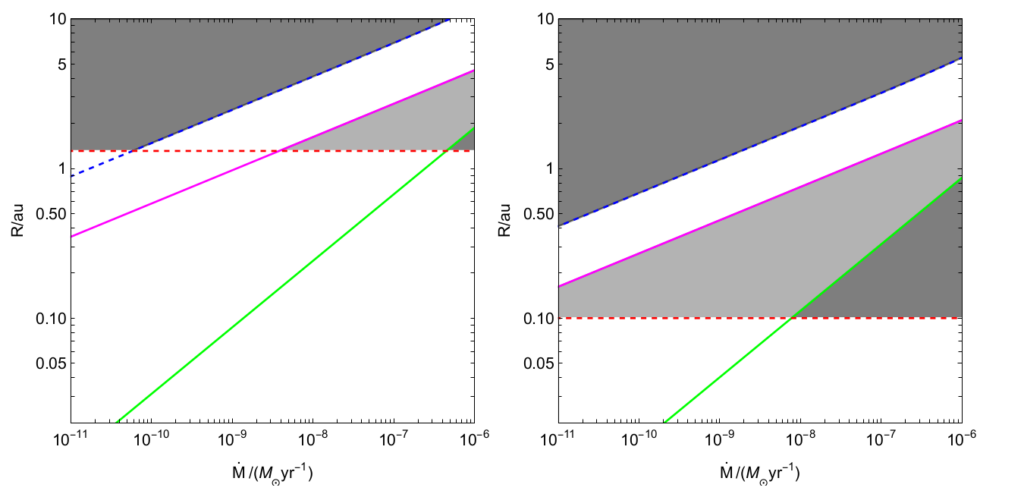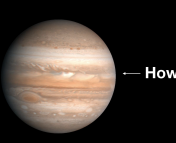Title: Formation of super-Earths in icy dead zones around low-mass stars
Authors: David Vallet, Anna C. Childs, Rebecca G. Martin, Mario Livio and Stephen Lepp
First Author’s Institution: Department of Mechanical Engineering, University of Nevada, Las Vegas, USA
Status: Accepted in MNRAS Letters

Source: NASA / JPL
The bigger the star, the more planets it holds, right? That would make sense, since bigger stars are known to form more massive protoplanetary disks after their birth and thus more material to create planets from. More material means more planets.
This intuitive idea is actually true for giant planets like Jupiter or Saturn, the so-called gas giants. However, in the case of planets of the super-Earth category which are fairly close to their star, their number actually decreases with the mass of the host star.
How is this possible? Shouldn’t a more massive protoplanetary disk simply mean that more planets, no matter their size and location, can be built from it?
Understanding this contradiction is vital if we want to gain a better idea on the general process of planet formation. Therefore, today’s authors have taken a closer look at the issue and may have come up with a possible solution.
Among several other parameters, such as the initial mass of the molecular cloud from which a star forms, one very important factor in terms of planet formation is the so-called snow line. This is the distance from a protostar, beyond which temperatures are sufficiently low (150 to 170 Kelvin) for ice grains to form in this environment. This line is at different distances for different stars.
At the snow line, the protoplanetary disk’s density of solid particles increases quite suddenly. Therefore, planets can form much faster beyond this line and become more massive. When looking at the solar system, we can still see the evidence of this, as our massive planets are all located in the outer orbits of the system. Of course, today we also know of massive planets, very close to their host stars (so-called “hot Jupiters”), however most scientists believe that they underwent migration to end up where they are now and did not form in-situ but rather much further out.
So, temperatures in the protoplanetary disk play a huge role in the time- and mass-scale of the formation of planets.
Today’s authors examined the temperature variations in protoplanetary disks around stars of different masses. They concluded that there might actually be a second icy zone within the inner parts of the disk, which has a greater radial extent for lower mass stars.
Previously, scientists have suggested that these disks may contain a dead zone, in which turbulent flow is suppressed due to low temperatures (below a certain temperature Tcrit) and high density (above a certain density Σcrit). Thereby, mass flow in the disk is prevented and the outer parts of the disk become self-gravitating (see Martin & Livio, 2012). This in turn increases the turbulence beyond this dead zone and thus temperatures there rise, pushing the snow line further out.
In the inner part of the dead zone, material piles up, as it cannot flow through and to the outer regions. The innermost regions of the protoplanetary disk are heated by the radiation from the central star. However, an icy zone within the dead zone appears to exist, according to simulations, where temperatures are dropping below 170 K, due to the distance from the star. This icy region is then broken up and interrupted by the rising temperatures in the outer disk beyond the dead zone, as explained above, before temperatures drop sufficiently again to define the outer snow line.
So. We have a cold zone with a lot of material built up close to a protostar. That’s good news for planet formation in this area.
In the next step to solve the riddle of fewer super-Earths close to massive stars than to less massive stars, the authors have taken a look at the extent of these dead zones for different stellar masses.
Circumstellar disks are defined, naturally, by the host star. Its mass, temperature and radius determine the general temperature structure within the disk.
The authors calculated the temperatures around 0.1 Msol M dwarf and a 1.0 Msol sun-like stars. Their results show that a secondary icy region is possible to exist for either.

Icy regions (shaded in dark gray) are thus possible where the irradiation temperature is low enough for ice to form as well as T < T_crit. It is shown that the inner icy region has a much larger extent for the smaller M dwarf.
Source: Fig. 1 from today’s paper
The outer radius of a dead zone is defined by where the disk becomes self gravitating due to a lack of mass flow from the inner regions. The inner radius of the dead zone is defined by where the temperature T drops below the critical value of T_crit (and the density is sufficiently high) to suppress turbulent flow. An icy region within the dead zone is located where the temperature from the stellar irradiation allows for ice to form. Thus, icy regions form in the areas shaded in dark gray in Fig.2.
As we can clearly see there, inner icy regions are much larger for smaller mass stars. While it’s true that more massive stars have more massive disks, there actually may just be more solid material within the inner regions of protoplanetary disks of smaller and cooler stars, making rapid core accretion in-situ possible, forming super-Earths.
The authors note that migration still needs to be taken into account when examining the occurrence rates of close-in super-Earths, as for example the TRAPPIST-1 system has planets with semi major axis between 0.01 and 0.06 AU, while the inner icy region during planet formation there would have been at approximately 0.1 AU.
An inner icy zone in protoplanetary disks must thus most likely be taken into account when looking at planet formation. This conclusion may lead us further along the path of discovering and understanding fascinating planets, just like the super-Earths, a type of planet we completely lack within the solar system.
Astrobite edited by Pratik Gandhi
Image Credits: NASA / JPL, today’s paper




